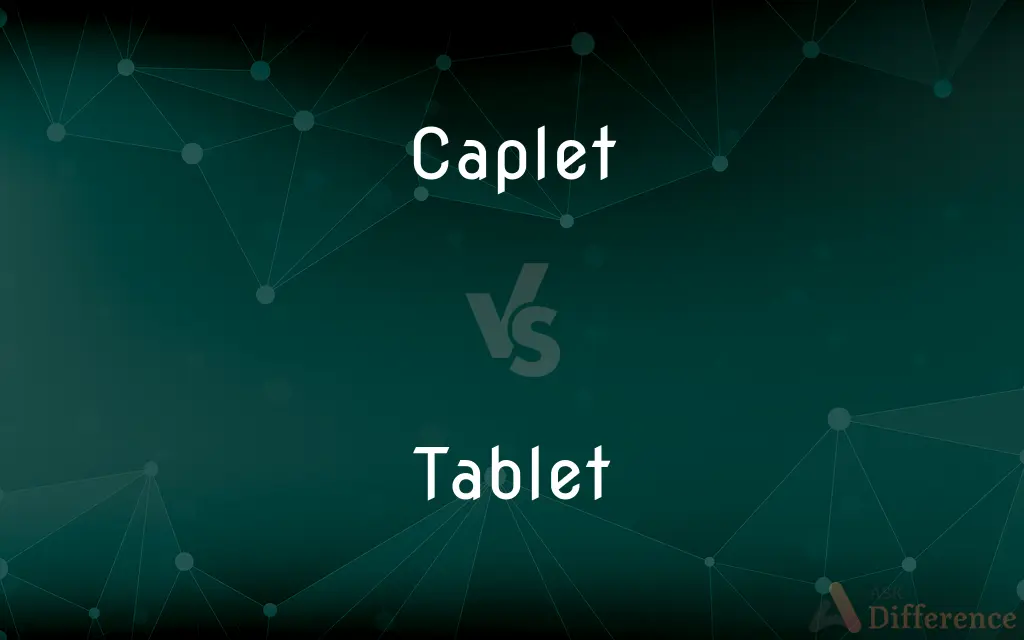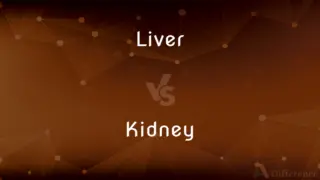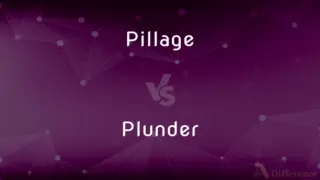Caplet vs. Tablet — What's the Difference?
By Tayyaba Rehman & Urooj Arif — Updated on January 30, 2024
A caplet is a smooth, coated, oval-shaped medicinal tablet for easier swallowing. A tablet is a solid dosage form of medication, typically round or oval, uncoated.

Difference Between Caplet and Tablet
Table of Contents
ADVERTISEMENT
Key Differences
A caplet is a type of medicinal tablet that is elongated and often coated, designed to make swallowing easier. It's a fusion of a capsule and a tablet, combining the ease of swallowing a capsule with the solid form of a tablet. On the other hand, a tablet is a traditional form of medication, typically round or oval, which may be coated or uncoated, but is usually harder and less streamlined than a caplet.
In terms of design, caplets are often smoother and more streamlined than tablets, making them more comfortable to swallow, especially for individuals who have difficulty swallowing pills. Tablets, however, are more conventional and can come in various forms including chewable, dissolvable, or extended-release versions, offering a wide range of options for different medicinal purposes.
Caplets are usually coated with a smooth, often shiny, layer which not only aids in swallowing but can also help mask the taste of the medication. Tablets may or may not have a coating; uncoated tablets can have a more pronounced taste and might be harder to swallow for some people due to their texture and shape.
The manufacturing process for caplets involves compressing the medication into an elongated, capsule-like shape, followed by coating. Tablets are made by compressing the medicinal substance into a flat or convex shape, and the process can include additional steps like scoring the tablet to make it easier to split.
In terms of usage, both caplets and tablets are taken orally, but caplets might be preferred by those who find regular tablets uncomfortable or difficult to swallow. Tablets offer versatility in how they release medication into the body, such as immediate release or controlled release, accommodating different medical needs.
ADVERTISEMENT
Comparison Chart
Shape
Oval, elongated, streamlined
Typically round or oval, varying shapes
Coating
Often coated for ease of swallowing
Can be coated or uncoated
Swallowing
Designed for easier swallowing
Can be harder to swallow for some
Taste Masking
Coating helps mask taste
Taste can be more pronounced
Manufacturing Process
Compressed into capsule-like shape, then coated
Compressed into flat/convex shape, may be scored
Compare with Definitions
Caplet
A smooth, coated, oval-shaped medicinal tablet.
I prefer caplets because they're easier to swallow.
Tablet
A small, compressed unit of medicinal substance.
The prescription says to take one tablet twice a day.
Caplet
Medication in solid form resembling a capsule.
The doctor prescribed me caplets for my headache.
Tablet
A non-liquid form of medication, often uncoated.
Chewable tablets are available for children.
Caplet
A coated, elongated form of a traditional tablet.
These caplets have a coating to mask the bitter taste.
Tablet
A traditional form of medication with various release mechanisms.
Extended-release tablets provide medication over time.
Caplet
A pill that combines the shape of a capsule and the solidity of a tablet.
Caplets are a convenient form of medication for many.
Tablet
A solid dosage form of medication, usually round or oval.
I take a vitamin tablet every morning.
Caplet
A tablet designed to be easily swallowed.
Caplets are great for people who struggle with pills.
Tablet
Medication designed for oral consumption in solid form.
Dissolvable tablets are convenient for those who dislike swallowing pills.
Caplet
A coated, oval medicine tablet.
Tablet
A slab or plaque, as of stone or ivory, with a surface that is intended for or bears an inscription.
Caplet
A smooth-coated tablet pill, as in medicine shaped like a capsule, used as a tamper-resistant alternative to a capsule, or an easy-to-swallow alternative to regular tablets.
Tablet
A thin sheet or leaf, used as a writing surface.
Caplet
(finance) A component of an interest rate cap, a derivative instrument that effectively prevents the interest payments on an otherwise variable-rate loan from exceeding an agreed level (the "cap"). Each "caplet", analysable as a call option, covers one interest accrual period (such as three months); the whole interest rate cap is made up of a series of consecutive caplets.
Tablet
A set of such leaves fastened together, as in a book.
Tablet
A pad of writing paper glued together along one edge.
Tablet
A lightweight, portable computer having a touchscreen as the method by which data is input.
Tablet
A small flat pellet of medication to be taken orally.
Tablet
A small flat cake of a prepared substance, such as soap.
Tablet
To inscribe on a tablet.
Tablet
To form into a tablet.
Tablet
A slab of clay, stone or wood used for inscription.
Tablet
(religion) A short scripture written by the founders of the Bahá'í faith.
Tablet
A pill; a small, easily swallowed portion of a substance.
Many people take vitamin tablets as a food supplement.
Tablet
A block of several sheets of blank paper that are bound together at the top; pad of paper.
Tablet
(computing) A graphics tablet.
Tablet
(computing) A tablet computer, a type of portable computer.
Tablet
(Scotland) A confection made from sugar, condensed milk and butter, produced in flat slabs, with a grainer texture than fudge.
Tablet
(rail) A type of round token giving authority for a train to proceed over a single-track line.
Tablet
(transitive) To form (a drug, etc.) into tablets.
Tablet
A small table or flat surface.
Tablet
A flat piece of any material on which to write, paint, draw, or engrave; also, such a piece containing an inscription or a picture.
Tablet
Hence, a small picture; a miniature.
Tablet
A kind of pocket memorandum book.
Tablet
A flattish cake or piece; as, tablets of arsenic were formerly worn as a preservative against the plague.
Tablet
A solid kind of electuary or confection, commonly made of dry ingredients with sugar, and usually formed into little flat squares; - called also lozenge, and troche, especially when of a round or rounded form.
Tablet
A slab of stone or wood suitable for bearing an inscription
Tablet
A number of sheets of paper fastened together along one edge
Tablet
A small flat compressed cake of some substance;
A tablet of soap
Tablet
A dose of medicine in the form of a small pellet
Common Curiosities
What makes a caplet different from a regular tablet?
A caplet is elongated and coated for easier swallowing.
Are tablets available in different forms?
Yes, including chewable, dissolvable, and extended-release.
Can I cut or break a caplet in half?
It's advisable to consult your healthcare provider or pharmacist before cutting or breaking caplets, as it may affect the intended release of the medication.
Can caplets have a time-release function?
Yes, some caplets are formulated for time-release.
Are caplets easier to swallow than tablets?
Caplets are designed to be easier to swallow for some individuals due to their smoother shape, but personal preference varies.
Do tablets come in different sizes and shapes?
Yes, tablets can vary in size, shape, and color, depending on the medication and manufacturer.
Is it easier to split a tablet than a caplet?
Generally, yes, especially if the tablet is scored.
Which form, caplet or tablet, is more commonly used for over-the-counter medications?
Both caplets and tablets are used for over-the-counter medications, and the choice depends on the specific medication and its intended purpose.
Can I request a specific dosage form from my pharmacist?
You can discuss your preferences with your pharmacist, but the choice of dosage form is often determined by the medication prescribed.
Are chewable tablets the same as regular tablets?
Chewable tablets are designed to be chewed and dissolved in the mouth, making them easier to ingest compared to regular tablets that need to be swallowed.
Can I switch between caplets and tablets of the same medication?
Switching between dosage forms should be done under the guidance of a healthcare provider or pharmacist to ensure consistent and safe medication use.
Do caplets and tablets have the same efficacy in delivering medication?
The efficacy of medication delivery can vary depending on the formulation and the intended release profile, which may differ between caplets and tablets.
Are caplets and tablets safe for children to take?
Some medications are available in child-friendly tablet or caplet forms, but dosing should always be supervised by a healthcare professional.
Share Your Discovery

Previous Comparison
Liver vs. Kidney
Next Comparison
Pillage vs. PlunderAuthor Spotlight
Written by
Tayyaba RehmanTayyaba Rehman is a distinguished writer, currently serving as a primary contributor to askdifference.com. As a researcher in semantics and etymology, Tayyaba's passion for the complexity of languages and their distinctions has found a perfect home on the platform. Tayyaba delves into the intricacies of language, distinguishing between commonly confused words and phrases, thereby providing clarity for readers worldwide.
Co-written by
Urooj ArifUrooj is a skilled content writer at Ask Difference, known for her exceptional ability to simplify complex topics into engaging and informative content. With a passion for research and a flair for clear, concise writing, she consistently delivers articles that resonate with our diverse audience.














































